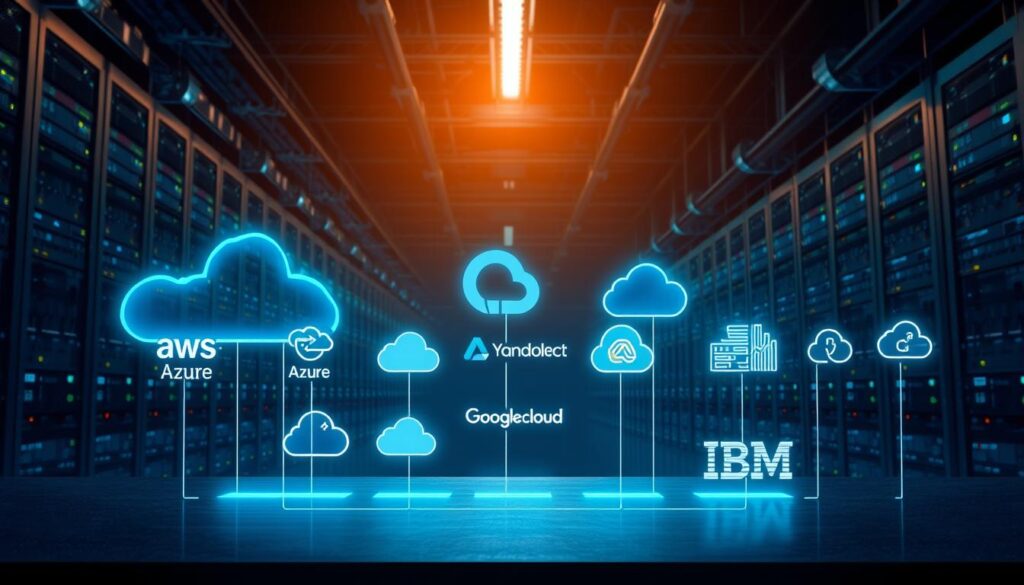Cloud Computing: Revolutionize Your Business with Scalable Solutions
Cloud computing is more than a trend; it’s a game-changer for businesses. It gives companies flexible IT resources that grow with their needs. You can get storage, apps, or processing power from cloud platforms like AWS and Microsoft Azure.
Think about cutting hardware costs and scaling services fast. Cloud services make infrastructure planning easy, freeing you to focus on innovation. Startups to big companies worldwide use this tech to stay ahead in the market.
Key Takeaways
- Cloud services provide scalable resources to match business needs.
- Leading providers like AWS and Microsoft Azure deliver reliable, secure platforms.
- Adopting cloud solutions can lower operational expenses and improve agility.
- Scalability ensures businesses can grow without upfront infrastructure investments.
- Cloud technology supports real-time collaboration and global team workflows.
Introduction to Cloud Computing
Cloud computing changes how businesses use technology. It offers computing resources like storage and power over the internet. This means no need for physical hardware.
At its heart, it provides scalable cloud solutions. These solutions can grow or shrink as needed. This is great for any business, big or small, offering flexibility without big upfront costs.
What is Cloud Computing?
Cloud computing is a way to deliver IT services. Instead of owning servers, users access data and apps online. This change means companies only pay for what they use.
For example, scalable cloud solutions allow businesses to scale up during busy times. Then, they can scale back when things slow down. This saves money and makes managing technology easier.
The Evolution of Cloud Technologies
Early computing needed big data centers, costing a lot upfront. By the 2000s, virtualization let many systems share one hardware. Now, cloud services offer instant access to global networks.
Innovations like AWS and Azure made scalable cloud solutions available to all. Today, cloud tech focuses on automation and AI. This is pushing what cloud can do even further.
Getting to know cloud basics is essential. From server virtualization to today’s dynamic platforms, cloud tech is changing business. As technology advances, scalable cloud solutions keep businesses competitive in a fast-changing market.
How Cloud Computing Empowers Businesses
Cloud computing changes how businesses work by offering cloud benefits that help them grow and work better. Teams can work together from anywhere, sharing files and working in virtual spaces. This means companies can quickly add or remove resources as needed, without being tied to physical places.
“Moving to the cloud cut our IT costs by 40% and freed us to focus on innovation.” – Tech Startup CEO
- 24/7 uptime reducing downtime risks
- Automated updates saving maintenance hours
- Data-driven insights via integrated analytics tools
- Rapid deployment of new applications in hours instead of weeks
Big names like Coca-Cola and NASA use the cloud to speed up product releases and handle big data. Sales teams get instant access to customer info with cloud-based CRM systems. Remote workers stay connected and productive with secure cloud tools, without needing to be in the office.
This gives businesses a big advantage. They can try out new ideas without a lot of risk, thanks to pay-as-you-go models. The ability to quickly adjust resources is perfect for today’s fast-changing markets, keeping companies flexible and ready to adapt.
Cost-Effective Scalability with Cloud Solutions
Business cloud computing changes how companies handle costs and resources. It lets businesses avoid paying too much for unused infrastructure. This way, every dollar spent is used effectively.
| Traditional IT | Cloud Computing |
|---|---|
| High upfront hardware costs | No upfront costs |
| Fixed capacity limits | Flexible scaling |
| Consistent maintenance fees | Pay-as-you-go pricing |
Optimizing Operational Costs
- Eliminate server maintenance and hardware upgrades
- Reduce energy consumption by 30-40% through virtualized resources
- Access automatic software updates without downtime
Expanding Capacity on Demand
With business cloud computing, scaling is no longer a big expense. Companies can:
- Boost storage or processing power during peak periods
- Downsize resources during slower seasons
- Align spending with real-time business needs
This flexibility lets businesses adapt to market changes without wasting money. Cloud solutions ensure costs grow with success, not with guesses.
Enhancing Business Agility Through Cloud Technologies
Cloud technologies are changing how businesses face challenges and seize opportunities. They allow for quick deployment and smooth integration. This means companies can change their strategies fast without losing cloud cost optimization. It’s not just about being quick; it’s about using resources wisely and on time.

Rapid Deployment and Integration
Setting up new apps or scaling up used to take weeks. Now, with platforms like AWS and Google Cloud, teams can launch services in hours. Tools like Terraform make setup consistent and keep cloud cost optimization in mind. This lets teams focus more on innovation and less on server management.
Adapting to Market Changes
“Agility in the cloud means turning market shifts into growth opportunities.” — TechCrunch, 2023
- Scale compute resources instantly during demand spikes.
- Use analytics dashboards to track customer trends in real time.
- Test new services in isolated cloud environments before full rollout.
Leveraging Automation
Automation tools like Azure DevOps and AWS Lambda cut down on manual work. Businesses automate tasks like data backups, security checks, and billing alerts. For example, automated scaling prevents overpaying for unused resources, keeping cloud cost optimization in check. This lets teams concentrate on strategy, not operational details.
Integrating Cloud Computing Into Your Business Strategy
Adopting cloud computing means matching tech with your business goals. First, check your current systems to see what can move to the cloud. Think about how sensitive your data is and what laws you must follow. This will help you pick the best cloud service for you.
“A seamless transition balances innovation with proactive cloud security planning.”
Plan your move in steps to avoid big problems. Start with apps that aren’t crucial, then move to important ones. Work with big cloud providers like AWS, Google Cloud, or Microsoft Azure. They have tools to make the switch easier. Always keep cloud security in mind to prevent risks.
- Evaluate current IT infrastructure
- Select cloud services aligned with business objectives
- Implement security protocols to protect data and systems
- Train teams on cloud tools and best practices
Don’t overlook cloud security risks. Regular checks and audits keep you in control. Aim for long-term gains like being able to grow and work more efficiently. A smart plan ensures cloud computing boosts your business safely.
Exploring Key Cloud Computing Services and Providers
Choosing the right cloud service model is crucial for your business. You have options like public, private, or a mix. Top providers like AWS, Microsoft Azure, and Google Cloud offer solutions for different needs.

Public vs Private Cloud
Public cloud services, such as AWS and Azure, offer scalable, on-demand infrastructure. They are managed by third-party providers. This model is cost-effective and flexible, perfect for businesses that value flexibility.
On the other hand, private cloud provides dedicated resources. It can be hosted internally or by a service provider. This is ideal for industries that need strict control over their data, like finance or healthcare.
- Public cloud: scalable, cost-effective, managed by third-party providers.
- Private cloud: dedicated resources, more control, secure environments.
Hybrid Solutions
“Hybrid cloud environments are the future of enterprise IT strategy,” emphasized a 2023 Gartner analysis, highlighting the rise of blended models.
Hybrid clouds mix public and private infrastructure. Companies like IBM and Oracle offer hybrid tools. These tools balance security and scalability.
This setup keeps sensitive data on private servers. It uses public cloud resources for non-critical tasks.
Innovative Service Models
Leading providers are innovating with serverless computing and AI-driven analytics. Google Cloud’s Vertex AI and Microsoft’s Azure Functions are examples. These tools automate workflows and integrate with existing systems.
Enterprise-grade options like Oracle Cloud Infrastructure and Alibaba Cloud offer global reach. They provide edge computing and AI/ML frameworks. These innovations make advanced tech available to small businesses too.
Security and Compliance in Cloud Computing
Keeping data safe and following rules are key when using cloud services. The private cloud is secure because it only serves one company. This means less chance of outside attacks. Businesses can also set their own security rules.
Important security steps include encrypting data and using multi-factor authentication. Regular checks also help. Following laws like GDPR or HIPAA is crucial. Here’s how to improve your security:
- Use firewalls and intrusion detection systems to monitor traffic.
- Implement role-based access controls to limit who can view or edit data.
- Partner with providers certified in ISO 27001 or SOC 2 for proven security practices.
“Security is a shared responsibility between the provider and the user.”
Choosing a private cloud means you have full control. It’s great for industries with strict rules like finance or healthcare. Training staff on phishing and data handling also helps. By focusing on these areas, you can keep your data safe and follow the rules while still enjoying cloud benefits.
Conclusion
Cloud computing is changing how businesses work, making things more flexible and efficient. It helps companies save money, be more innovative, and stay ahead. Hybrid cloud computing is especially good, mixing public and private clouds to meet different needs.
Providers like AWS, Microsoft Azure, and Google Cloud offer custom hybrid models. These models balance security and ease of access.
Choosing the right cloud approach is about matching technology with your goals. Hybrid cloud computing lets businesses keep sensitive data safe on private servers. At the same time, it uses public clouds for easy scaling.
This setup cuts down on downtime and meets regulatory needs. It’s perfect for finance or healthcare.
Being agile is crucial as markets change. Companies that use hybrid cloud solutions can quickly respond to new trends and customer needs. Start by checking your current systems and looking for partnerships with trusted cloud providers.
The future of business is in the cloud. Don’t wait to use its power today.
FAQ
What is cloud computing?
Cloud computing means using the internet to get computing services. It lets businesses use servers, storage, and software when they need it. This makes things more flexible and efficient.
How can cloud computing benefit my business?
Cloud computing helps your business in many ways. It makes teamwork better, lets you grow easily, and gives you quick access to data. It also cuts down costs.
What are the different types of cloud services available?
There are three main types of cloud services. You have Infrastructure as a Service (IaaS), Platform as a Service (PaaS), and Software as a Service (SaaS). Each one offers different levels of control and flexibility, depending on what your business needs.
Is cloud computing secure?
Cloud computing is very secure. Cloud providers use strong security like encryption and access controls. They also do regular checks to keep data safe. Businesses should also follow best practices to protect their data even more.
How do I choose the right cloud service provider?
Choosing the right cloud provider is important. Look at their services, reliability, security, and customer support. Think about what your business needs now and what it might need in the future.
Can I integrate cloud computing with my existing IT infrastructure?
Yes, you can mix cloud computing with your current IT setup. Many businesses use a mix of on-premises and cloud services. This creates a flexible and efficient system that uses resources well.
What is the cost structure of cloud computing?
Cloud computing costs are based on what you use. You only pay for what you need. This helps keep costs down and avoids big upfront expenses.
Can small businesses benefit from cloud computing?
Absolutely! Cloud computing helps small businesses a lot. It lets them use powerful tools without spending a lot. This helps them innovate and compete better.
What do I need to consider before migrating to the cloud?
Before moving to the cloud, think about your current IT setup, data security, and regulatory rules. Also, think about what your business really needs. A good analysis will help make the transition smooth and successful.



